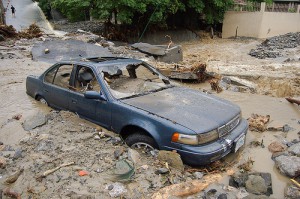Northern states have been hard hit by the severe rainstorms associated with the passage of Hurricane Alex on 1 July 2010.
News reports say that at least six people have been killed, one by a mudslide which engulfed her car. The infrastructure in many parts of northern Mexico has been badly damaged.
In Nuevo León, a state of emergency was declared in 21 municipalities, including the Mexico’s second largest city Monterrey. The municipalities affected are Anáhuac, Apodaca, Cadereyta Jiménez, Cerralvo, China, Ciénega de Flores, Doctor Coss, General Escobedo, General Treviño, Guadalupe, Hualahuises, Linares, Los Aldamas, Los Ramones, Melchor Ocampo, Montemorelos, Monterrey, San Nicolás de los Garza, San Pedro Garza García, Santa Catarina and Santiago.
Declaring a state of emergency allows states to access funds held in Mexico’s Fund for Natural Disasters (Fonden).
The storms washed dozens of vehicles into nearby rivers and damaged bridges and protective barriers. Intercity bus service were suspended in various areas until highways blocked by rocks and mud could be cleared.
Despite record rainfalls of up to 820 mm (a year’s worth of rain in just three days!), the storms left 110,000 people in the state without water, and 140,000 without power. Thousands are homeless and have relocated to emergency shelters. The director of the National Water Commission warned that the El Cuchillo dam had reached 124% of its capacity and ordered excess water to be allowed to flow down local rivers.
Damages were also considerable in two neighboring states, Tamaulipas and Coahuila. In Tamaulipas, a state of emergency was declared in 22 municiaplities (Mainero, Villagrán, Hidalgo, Victoria, San Fernando, Méndez, Burgos, Villas Aldama, González, Matamoros, Reynosa, Valle Hermoso, Río Bravo, Soto la Marina, Jiménez, Abasolo, Jiménez, Casas, Mante, Llera, Padilla and Güémez). Damages in Tamaulipas alone were estimated to exceed 100 million dollars.
In Coahuila, one person is still missing. The storm hit 8 municipalities especially hard: Nadadores, where one person was reported missing, Monclova, Saltillo, Ramos Arizpe, Parras, Sacramento, La Madrid, and the Sierra de Arteaga.
While most damage was concentrated in northern states, several municipalities in southern Mexico, including Guerrero and Oaxaca, also reported damage.
Earlier post about the build-up to Hurricane Alex.
Hurricanes and other climatological phenomena are analyzed in chapters 4 and 7 of Geo-Mexico: the geography and dynamics of modern Mexico. Buy your copy today, so you have a handy reference guide available whenever you need it.
Click here for Deus Ex Camera’s photo collection about Hurricane Alex.

